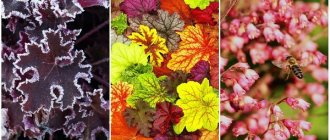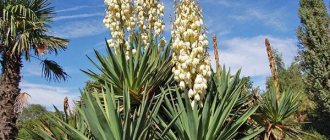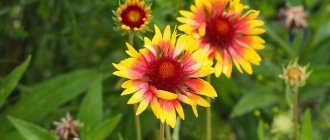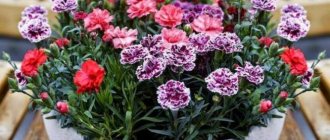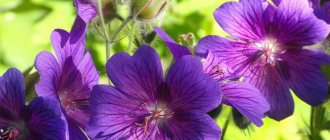The rhizomatous perennial herbaceous plant Heuchera is a member of the Saxifraga family. Today its varieties and types are highly valued in landscape design.
Photo. Heuchera in a flower bed.
Did you know that... This plant was named after the German doctor and botanist Johann Heinrich von Heicher.
The cradle of culture is the rocky regions of North America.
Heuchera bushes are compact, reach a height of about 50 centimeters, and are valued for their spectacular foliage, which attracts the eye with its sophistication.
A distinctive feature of the plant is that during one growing season its foliage can change color several times.
This crop is distinguished by an incredibly diverse color palette, as well as many options for combinations of color shades, especially for modern variegated varieties.
Brief description of the plant
- Landing. In spring, suitable months are March-April.
- Bloom . Observed in June-August.
- Lighting. Grows well in shade or in bright, but diffused light, without direct sunlight.
- The soil. Must be moisture-resistant, breathable and water-permeable with a pH of 5.0-6.0.
- Watering . Systematically water the plant when the soil dries out once every two to three days. During long periods of warm, dry weather, water the flower twice a day.
- Fertilizer . Feeding begins from the second year of growth, this is done before flowering and after flowering. To do this, use liquid complex mineral fertilizers in half the dose recommended by the manufacturer.
- Reproduction. By dividing the bush into cuttings, as well as sowing seeds.
- Insect pests. Weevils, leaf nematodes, butterfly caterpillars, snails and slugs.
- Diseases. Gray rot, stains, rust, powdery mold.
Basic moments
In order for a garden shrub to grow healthy and delight you with rich colors, you need to worry about proper care for it. The plant prefers to grow in partial shade and does not tolerate bright rays of the sun.
Garden shrubs are widely used in landscape design. It can be planted not only in open soil, but also in a pot on a loggia or balcony.
Appearance
Heuchera is a compact and dense bush, which consists of blades of long-leaved, leathery leaves with a jagged edge.
Photo. Heuchera leaves.
The color and shape of the leaves are very diverse. They can be almost black, brown, pink, yellow, deep red, amber, purple, green and even silver, and have various veins, patterns and spots on their surface. The texture of the leaf plates is corrugated, smooth and curly. The bushes are decorated with flowers throughout the summer, and in some cases even until the first frost.
Photo. Heuchera flowering.
Paniculate inflorescences consist of small bells of white, red, pink or cream color. The fruit is a capsule containing many seeds the size of a poppy seed (1 g contains about 20,000 seeds).
Heuchera care video
Today, heucheras are considered the most attractive and popular decorative foliage plants, which are gladly used by gardeners for landscaping the garden.
The flower is distinguished by a wide variety of shades and shapes of leaves, as well as a completely unpretentious character, resistance to diseases and pests. In addition, heuchera is frost-resistant and easily overwinters in the garden. It is often planted in flower beds, rockeries, rock gardens and on central paths. You can also share your secrets for caring for heuchera. If you have questions, ask them in the comments below, we will be happy to answer them.
Characteristic
If you do not plan to collect seeds, you can cut the flowers.
It is not difficult to grow heuchera on your own plot, but it has several features that a gardener who decides to grow this perennial species should know:
— If you grow decorative and deciduous varieties of heuchera, then you need to cut off the flower stalks that appear in the bushes; they tower above the plants and look extremely disorderly. Peduncles are left only if the seeds are going to be collected in the fall.
— In decorative flowering varieties, the flower stems are cut off immediately after flowering. The lower foliage flies off over time, which negatively affects the decoration of the plant.
And a note! Before the bush begins to bloom, it is taken out of the ground and planted in a new, deeper hole with clods of earth, thanks to this it will be possible to hide the bald trunk.
- Young foliage begins to grow in rich, translucent colors (similar to flower petals), but becomes darker and denser over time.
— Heuchera bushes go well with daylilies, primroses, astilbe and ornamental grasses.
Types and varieties of heuchera
Heuchera species are conventionally divided into mountain and forest. In mountain species, of which there are much more than forest species, the leaves are leathery, denser, and the rhizomes are adapted to survive in rocky soil, so rich soils are destructive for them. Forest species adapt more easily and quickly to fertile and moderately moist soils, and they are more spectacular and attractive than mountain species, which is why they are more often used in gardening. We will introduce you to the most commonly cultivated types of heuchera.
American heuchera (Heuchera americana) is a forest species that grows in eastern North America - on the rocky shores of the Great Lakes. What is attractive about Heuchera Americana is the leaves that form a rosette up to 20 cm high: rounded, heart-shaped, long-petioled, sometimes brownish-purple on the underside of the plate. The upper side of the leaves combines silver and velvet-brown spots and veins on a green background at different times of the year. A characteristic feature of cultivars of this species is a thin rim along the edge of the leaf blade. It can be crimson, coral or bright red. On peduncles up to 60 cm high, panicles of yellow-green flowers are formed. The species has been in culture since 1656. An interesting variety of this species, recently bred in New Zealand:
- Green Spice, or Eco Improvd , is a plant with green leaves covered with contrasting silver spots that do not lose freshness throughout the season. At a young age, a slight yellowness appears on the leaves of the plant along the green field, and purple-red areas around the veins, but over time, both redness and yellowness disappear, the silvery spots become brighter, and the green background is darker.
Heuchera micrantha is the most spectacular natural species of the genus. This is a perennial heuchera that is found in the wild on the North American Atlantic coast. It forms loose small-colored panicles of creamy-pink flowers with red-orange anthers on peduncles up to 60 cm high. The small-flowered leaves of heuchera, covered with gray-silver spots, resemble the foliage of Norway maple. There are natural varieties of the plant with purple leaves, and breeders have been able to enhance this trait and create forms with foliage in bright colors. The most famous varieties of Heuchera parviflora:
- Palace Purple is a plant up to 50 cm high. The leaves are bright purple with a metallic tint;
- Brassingham Bronze is a heuchera with bronze-brown foliage.
Heuchera cilindrica is a mountain species found in the highlands of the American Pacific coast. This plant is distinguished by large flowers of coral, pink, green or beige, located on peduncles up to 90 cm high, and small green, heart-shaped, rounded leaves with contrasting venation or a silver pattern collected in a compact rosette. The alpine variety of heuchera cylindrical has three cultivars:
- Greenfinch is a plant with greenish-cream flowers on tall peduncles;
- Hyperion is a compact form with red-pink flowers on peduncles up to 50 cm tall;
- Green Ivory is a heuchera with cream flowers on arrows up to 70 cm high and dark green leaves with bluish-red veining.
Blood-red heuchera (Heuchera sanguinea) naturally grows in the mountainous regions of the United States and northern Mexico, but, oddly enough, it is characterized by such high winter hardiness that it easily tolerates frosts in the middle zone. Americans call this plant red bell. The pubescent, round leaves of this species with a serrated edge are denser than those of other members of the genus. They form a rosette up to 25 cm high. On peduncles up to 50 cm high, small crimson, red or pink bell-shaped flowers are formed, forming a beautiful oblong panicle up to 20 cm long. The plant blooms in June-August from 60 to 90 days. The species has been in cultivation since 1882. The most interesting varieties of blood-red heuchera:
- Alba is a plant with green leaves and compact inflorescences ranging in color from white to dark red;
- Robusta is a variety with green leaves that turn red towards the end of the season and large dark red flowers;
- Snowstrom is an early flowering variety (May-June) with variegated white-green leaves and bright red flowers;
- Splendence is a variety with green leaves and compact inflorescences of bright carmine-red flowers;
- Splash-splash is a heuchera with green leaves with light green spots, the veins of which acquire a red-crimson color by the end of the season. The flowers are pink.
Hybrid heuchera (Heuchera x hybrida) - this category includes mainly interspecific hybrids obtained from crossing American heuchera, blood-red and small-flowered heuchera. Lemoine called this group of hybrids Heuchera x brisoides . These plants most closely resemble blood-red heuchera, but their terrestrial organs are larger. They bloom profusely for two months with pink, coral, white or red flowers. Their leaves are large, with contrasting veining, usually green with cream or white specks. The only drawback of plants of this group is that in a strong wind, the arrows overloaded with flowers can lie down. This species also includes more complex hybrids formed from Heuchera americana and Heuchera parviflora with the participation of other species of the genus. This group is called American hybrids ( Heuchera x americana) .
The best varieties of hybrid heuchera are:
- Amber Waves is a variety with corrugated and somewhat elongated leaves of amber-yellow color, especially bright in the spring under the sun's rays, but in the shade they acquire a light green hue. The flowers are light pink;
- Amethyst Mist is a plant with foliage of a dark amethyst color, unusual for heuchera, covered with silver spots. By autumn, the leaves become slightly crumpled and acquire greenish-burgundy tones, and the spots on them become lighter;
- Autumn Hayes is a variety with softly pubescent, light brown leaves with dark veins when young. Gradually the leaves become dark green with silver spots;
- Black Beauty - heuchera with highly corrugated, glossy leaves on the upper side of a dark burgundy-purple hue;
- Kan-Kan - a variety with highly corrugated red-brown leaves with light silver spots;
- Mint Frost is a plant with cream-colored branches and green leaves with silver spots that turn silver-bronze after frost;
- Cascade Don is a variety that changes the color of the foliage: young leaves are green with raspberry-purple areas and dark brown veins, but over time they become dark green with an admixture of purple hues and are covered with light silver spots.
Heuchera hybrids such as Coral Cloud, Brandon Pink, Firebird, Huntsman, Jubilee, Lady Romney, Hellen Dillon, Persian Carpet and many others are also popular.
Species such as heuchera pilosa and gooseberry leaf can also be found in
gardens, but they are of greater interest not for gardeners, but for breeders.
But a plant such as Heucherella - a man-made species obtained from crossing Heuchera with Tiarella cordifolia - is quickly gaining popularity in amateur gardening. The flowers of this plant resemble heuchera, but it inherited the shape of the leaves and small habit from tiarella. Today, three varieties of heucherella have already been bred:
- Bridget Bloom is a plant with green leaves and coral-red flowers on a peduncle up to 45 cm high;
- Rosalie is a variety with yellow-green foliage in spring, which darkens over time and becomes red-brown along the veins. On a peduncle 45 cm high, inflorescences of coral-pink flowers of a dark shade are formed;
- Quick Silver is a heucherella with brown leaves covered with a gray-ashy coating and inflorescences of silver-white flowers on peduncles up to 60 cm high.
Planting heuchera in open ground
We plant heuchera.
Illustration taken from open sources. What time to plant?
Plants are planted in open ground in March-April. This plant loves shade and partial shade, so we recommend choosing an area that will be shaded by other crops. The diffused sun should fall on the flower.
On a note! Choose a place located in the western or eastern part of the garden; direct sunlight should fall on it only in the morning or evening.
If a sunny zone was chosen for the heuchera, the plant will need to be watered systematically and very abundantly. It was noted that if varieties with bright foliage are grown in well-lit open areas, then their color becomes more saturated and spectacular. It should be noted that varieties with red foliage are recommended to be grown only in sunny areas, otherwise their color will be green after shading.
When to plant heuchera seedlings in 2022
Before you begin preparing for sowing, it is important to decide when you will plant heuchera seedlings. Planting is best done in the second half of March or early April. The choice of timing depends on the gardener’s place of residence: in the south it is better to sow in the first half of March, in the middle zone it is better to plant in the 2nd or 3rd decade of the month, in Siberia and the Urals it is optimal to sow in early April.
By the way! A good guide when choosing the time for the procedure is the cycles of the moon. Thus, the timing of planting heuchera seedlings according to the Lunar calendar 2022:
- Favorable days: in January: 1, 10, 11, 15, 16, 19, 20;
- in February: 7, 8, 12, 13, 14, 15;
- in March: 10, 11, 15, 20, 21, 24, 25.
- Unfavorable days: in January: 2, 18th;
- in February: 1, 16;
- in March: 2, 16, 17, 18, 31.
The soil
The culture is not particularly demanding on the soil and can grow on any soil except acidic soil; it is better if the pH is 5-6. It can grow on rocky soil, as the plant is naturally found on the rocky shores of the Great Lakes of North America.
On a note! Remember that the looser and more nutritious the soil, the more spectacular and dense the bush will be.
Particular attention should be paid to the moisture capacity of the soil, and it must allow water and air to pass through well. The plant reacts negatively to stagnant fluids in the root system.
Heuchera transplant
Experts do not recommend replanting young bushes. Only strong, mature plants can be replanted. If you transplant a young heuchera, it may die.
When digging, be careful not to damage the fragile root system. Ash should be poured into the prepared planting hole.
Healthy and mature plants tolerate replanting well and easily take root in almost any part of the garden.
Landing rules
Heuchera seeds ripen after flowering.
Heuchera can be grown from seeds, or you can buy ready-made seedlings. Sowing is done in prepared loose soil and covered.
On a note! If you want to grow a crop from seeds, keep in mind that the seedlings cannot retain the varietal characteristics of the mother plant, and all you can grow is a simple bush with green foliage.
If you decide to grow a flower from seeds, we recommend doing it through seedlings. The seedlings are grown in a greenhouse, after which they are planted in open ground, maintaining a distance between bushes of at least 20 centimeters, and they are buried in the soil only 3-4 cm.
Why is it recommended to grow heuchera from seeds?
This ornamental plant reproduces by vegetative and seed methods, and it is the latter method that is most often recommended by experienced gardeners, since it is quite simple and effective. But there is one important nuance - with the seed method, the varietal characteristics of heuchera are not preserved. At the same time, the grower has the opportunity to get a new hybrid with an unusual color.
This is what the heuchera seed boxes look like
Those who wish to experiment are advised to resort to the optimal method, namely the seedling method. The gardener will need to purchase seeds of a suitable variety in the store or collect them with his own hands.
Top dressing
Don't forget to feed the plant.
After planting in the first year of growth, the bush does not need feeding. Then annually during the growing season. If you grow ornamental and deciduous varieties, then complex mineral fertilizers for deciduous plants are used for fertilizing, and when growing ornamental and flowering varieties, use universal fertilizers for flowering plants. Fertilizers are applied to the soil twice a season, namely before and after flowering, using half the dose recommended by the manufacturer .
Selection of location and conditions of detention
Let's find out under what conditions the heuchera should be kept so that it does not get tired of blooming, and its leaves remain just as beautiful.
Lighting and location
Heuchera likes to grow in areas with moderate lighting. It is better for her to set aside a place where the sun shines only in the morning, and during the day it forms partial shade. The flower tolerates a lack of light better than its excess.
Temperature
The optimal temperature for heuchera is +20…+25 oC. But it easily tolerates cold summers, spring and autumn frosts. In winter, the flower can tolerate frosts down to -35...-30 °C. Therefore, they build a light shelter for him for the winter.
Air and humidity
It is better not to plant Heuchera in open areas, as it does not like draft winds. The flower prefers moderate air humidity (40-70%), which is independently maintained throughout the growing season.
Priming
Despite the fact that heuchera grows on rocks in the wild, it achieves its greatest decorative value when grown in light, nutritious and well-drained soils with a neutral or even slightly alkaline reaction.
Watering
Flowers should be watered regularly once every two days immediately after the topsoil has dried. Heuchera is one of the plants that tolerate drought much better than stagnation of liquids in the root system. But during long warm and dry periods, watering is carried out twice a day (early morning and late evening). Water the bushes very carefully, pouring water under the root and not allowing drops to fall on the surface of the foliage, as this can cause burns.
To avoid frequent weeding and regular loosening, in the spring after watering, the soil surface is covered with a layer of mulch (peat).
Heuchera is propagated by dividing the bush.
Heuchera, planted and cared for correctly, loses its aesthetics every 3-5 years. In this case, the plant can be replanted. It is preferable to do this before or after flowering. For example, in the spring after new leaves appear or in the fall, when the plant finishes blooming.
It is preferable to replant heuchera before or after flowering.
To replant, the heuchera is carefully dug up and divided into several small bushes to expose the main stem. It is trimmed to young tissue. Dead shoots should be pruned to small living small buds. They are located in the axils of dead old leaves. After this, it is necessary to shorten the excessively overgrown roots and remove their rotten areas, leaving only healthy tissue. All cuts are sprinkled with crushed coal.
After transplantation, the plant must be protected from excessive sun.
For planting, you need to choose a shaded place and dig holes measuring 30x30 cm. Ash and any mineral or compost fertilizer are poured into them. Then a plant is planted, which must be watered immediately. The growth of a new root system usually occurs within 40-45 days. All this time, the plant must be covered from excessive sun. Then the heuchera can be transplanted to its permanent place.
Heuchera reproduces well by seeds
Reproduction
Photo.
Perennial heuchera. Once the bush reaches three to four years of age, a bare middle may appear as the bush's output in most cases disintegrates. If this happens, then the flower should be rejuvenated.
To do this, they dig it up, divide it into several parts, and each piece is planted in a new place.
The division of the bush is carried out in May or in the first weeks of autumn. It should be borne in mind that each division should have two or three processes. If the roots of the division are excessively long, they are shortened and if there is rot on them, then all affected parts are cut off, and the cut areas are sprinkled with crushed charcoal.
Pests and diseases
The culture is very resistant to insect pests and various diseases. However, it can rarely be affected by rust, stains, powdery mildew or gray mold. As a rule, this is due to the fact that the liquid regularly stagnates in the root system or an excessive amount of fertilizer in the soil.
If a whitish coating appears on the foliage, then the plant is affected by powdery mildew. To cure it, treatment with fungicidal drugs is necessary. If the flower is sick with rust or spots, it needs to be sprayed every two weeks with a solution of Bordeaux mixture.
Insect pests that can harm the plant include slugs, caterpillars, snails, weevils or leaf nematodes. To destroy them, the bush is treated with special insecticidal preparations.
Wintering
Autumn has arrived, which means we need to take care of the wintering of Heuchera.
The crop is quite frost-resistant in open fields. In autumn, yellowed and dried leaf blades cannot be cut from the bush, since in winter they protect the root system from frost. The plant should be covered for the winter, while it is recommended to use covered oak leaves as cover. With the arrival of spring, the cover is removed, and the old foliage from the bush is carefully trimmed with pruning shears as close to the surface of the area as possible.

